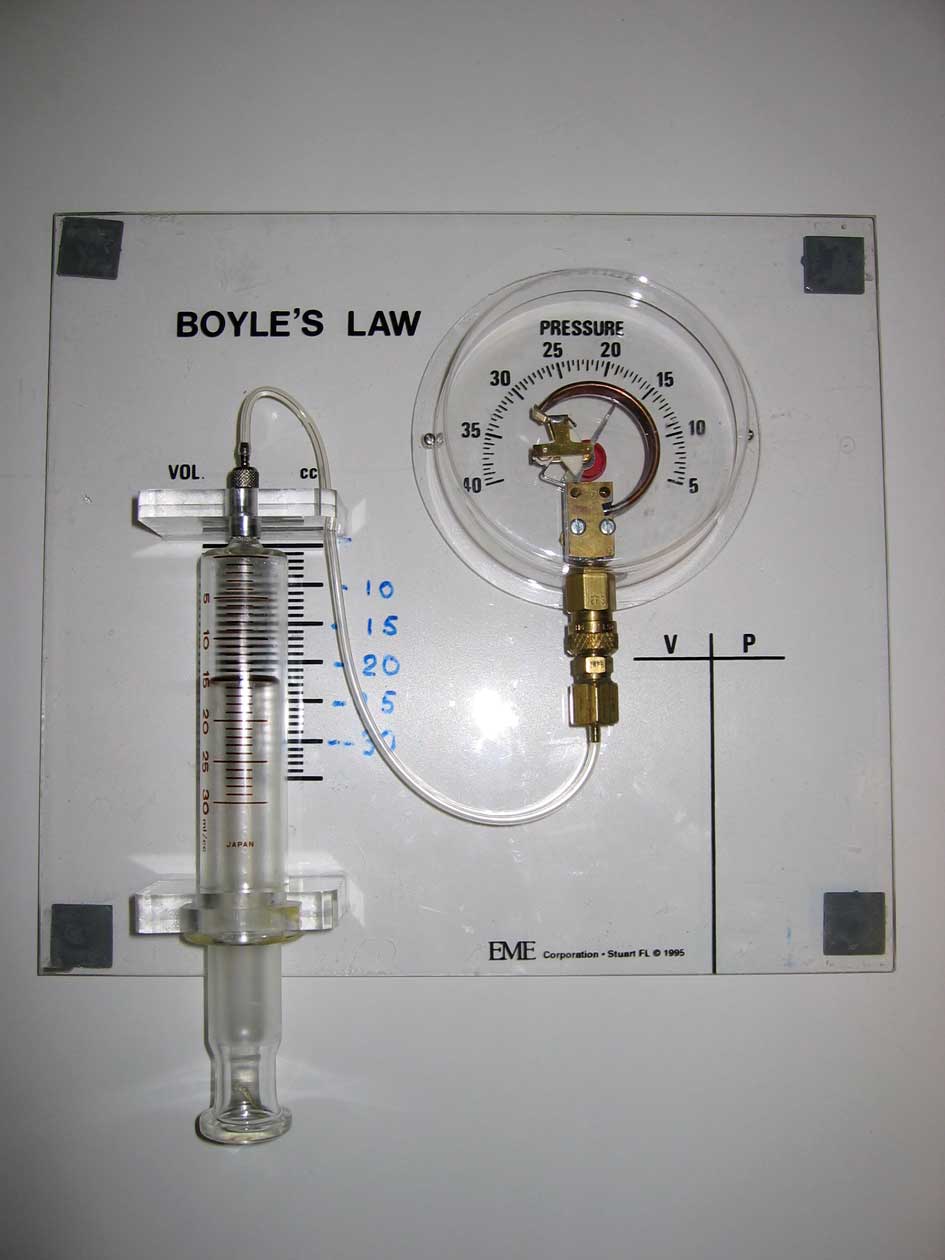The thermodynamics of compression or expansion of an ideal gas
 The thermodynamics of the compression or expansion of an ideal gas is qualitatively and quantitatively explored.
The thermodynamics of the compression or expansion of an ideal gas is qualitatively and quantitatively explored.
Ingredients: gas pressure gauge, syringe
Procedure: A complete recipe follows.
1. Place a fixed quantity of gas in a syringe.
2. Vary the volume of the gas in the syringe, observing the change in pressure.
3. Analyze the heat added to the gas, the work done on the gas, and the change in energy and enthalpy of the gas.
Understanding: The ideal gas is one of the few models for chemical processes where we have a complete knowledge of the thermodynamics of the system. We have in hand the equation of state, PV=nRT. For the simple atomic ideal gas, we also have an exact expression for the internal energy, E=(3/2)nRT. The ideal gas provides us with the opportunity to compute the full array of first law properties, from changes in energy and enthalpy, to heat and work.
In the experimental process, the gas is compressed isothermally from an initial pressure of 1.0 atmosphere and volume of 30.0 mL to a final pressure of 3.0 atmospheres and a volume of 10.0 mL. The temperature throughout is 20.0C. The isothermal compression of the gas was performed in two ways, one irreversible and one reversible.
Irreversible isothermal compression
The irreversible compression of the gas proceeds in one step against a constant external pressure of 3.0atm. The work is given by
w = -PextΔV = 0.060 Latm
How do we compute the heat added to the gas? Indirectly! We note that the process is isothermal. The total energy of the ideal gas is
ΔE = n cVΔT
ΔE = q + w
The heat added to the system is negative because the gas is compressed. Why? In the absence of heat transfer, the gas will gain internal energy in the compression and its temperature will increase. To keep the temperature of the gas constant, the gas must transfer a positive amount of heat to the surroundings. So the heat added to the compressed gas is negative, keeping the temperature constant.
Finally, for an ideal gas
ΔH = n cPΔT
Reversible isothermal compression
The reversible compression of the gas proceeds in an infinite number of infinitesimal steps, where the external pressure applied is always essentially equal to the internal pressure of the gas (or larger only by an infinitesimal amount). The work is given by
w = -nRT ln(V2/V1) = -(0.030 Latm) ln(0.010L/0.030L) = 0.033 Latm.
wirr > wrev
We compute the heat added to the gas as we did for the irreversible process. Indirectly! Again the change in energy of the system for the isothermal process is
ΔE = 0
Note that the change in energy must be the same for the reversible and irreversible processes because the initial and final states of the gas are the same. As the change in energy depends only on the initial and final states of the system, it is independent of the path followed. It follows that ΔH=0.
Reversible adiabatic compression
In an adiabatic process, the heat added to the system is zero or
q=0
From the definition of the adiabatic process, we have q=0. How do we compute the change in energy of the system? We can't do that by computing the work done on the system. We need to determine the change in energy of the system, and then compute the work done on the system through the first law.
The change in energy of the system is
ΔE = n cVΔT
T1V1cP/cV-1 =
T2V2cP/cV-1
We know the initial and final volumes, and we know the initial temperature. We can compute the final temperature which is 609K. The change in energy can then be computed using the fact that for this simple ideal gas
cV = (3/2) R
From the first law of thermodynamics it follows that w=ΔE-q=ΔE=0.049 Latm. This makes sense. As the gas is being compressed, a positive amount of work is being done on the gas.
Finally, we know that for any ideal gas
ΔH = n cPΔT
cP=cV + R
In the irreversible process, the gas is isothermally expanded in three steps: It is first expanded to a volume of 2.0 liters against an external pressure of 5.0 atmospheres, followed by an expansion to 5.0 liters against an external pressure of 2.0 atmospheres, followed by an expansion to 10.0 liters against an external pressure of 1.0 atmosphere.
In the reversible process, the ideal gas is isothermally expanded from its initial state to a final volume of 10.0 liters.
For the reversible and irreversible expansions, compute the heat added to the system, the work done on the system, the change in energy of the system, and the change in enthalpy of the system.
You can check your answers here.
Reversible and irreversible isothermal expansions of an ideal gas
Question:
A monatomic ideal gas is initially contained in a 1.0 liter vessel at 10.0 atmospheres of pressure and a temperature of 121.8K. The gas is then allowed to expand isothermally along two distinct pathways.